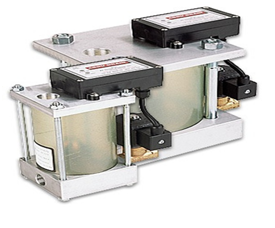Your Compressor’s Health Depends On The Air Compre…
Posted by AVP on Mar 5th 2022
Moisture condensation is unavoidable during the generation and distribution of compressed air. It's common for it to be contaminated with oil and other irritants, which can be very dangerous at times. When it comes to polluted air, AVP understands the dangers of more maintenance, higher operational expenses as well as the early breakdown of and replacement of equipment. In order to help you better grasp the necessity of air compressor drain valves, this blog article is a must-read for you.
Drain valves are a standard feature on almost every air compressor, no matter how large or tiny, old or new it is. This is a critical component of the tool, one that is commonly misunderstood. A drain valve refers to the little valve at the base of an air compressor that allows compressed air to escape. It is, as the name implies, a device for emptying the tank of an air compressor. That which you get when you open the valve comes as a shock to many—water.
The Art of Air Compressor Upkeep
You can increase the life of your air compressor by maintaining it properly. Draining your air receiver on a regular basis is an important minor activity. Water vapor is naturally present in the ambient air that is sucked into the receiver of your air compressor.
Water vapor condenses as the air is compressed and accumulates in the receiver. Moisture will accumulate over time and has to be eliminated in order to avoid damage to your air receiver, which might take the form of rust.
An air compressor drain valve is commonly found on the underside of most compact compressors for household or light commercial use. You may open this valve simply by unscrewing it, allowing the air receiver to dry out.
When emptying your air receiver, be sure to use gloves to protect your hands from any dirty particle substance or oil that may have fallen out during air compression. Also, save your workshop floor from a nasty mark by putting the collected water in a container.
Allow any residual moisture in the air receiver to dissipate over time by leaving the drain valve open after draining it. To prevent your air compressor from running indefinitely without creating any pressure, always shut the drain valve completely prior to using your air compressor again!
Draining An Air Compressor
General guidelines for utilizing an air compressor. Always consult your tool's handbook for appropriate usage and maintenance.
1. Disconnect the compressor and any tools attached.
2. Lower the pressure as much as you can. Before using the drain valve, the pressure should be below 10 psi. Air tank pressure should be close to zero when you're done. Make sure you're reading the right gauge!
3. Put a bucket or a drip pan underneath the valve. This will keep the water in.
4. Activate the drain. Unscrewing a screw or twisting a knob is one way to go about it.
5. Close the valve after the liquid is withdrawn.
You should be done after all that hassle. Easy.
However, after years of doing this business, we, at AVP have witnessed numerous incidents where the above-mentioned steps are not regularly followed. And even doing it repeatedly each time an air compressor draining is required, there will always be a misstep that could cause a serious error in the workplace or at home.
Types of Air Compressor Drain Valve
Timer Controlled
Timer-controlled drains are an example of an alternative method of draining. The level of the water is not measured by the valve. An electronic timer, rather than a mechanical one, is used to open or close the valve at predetermined intervals set by the operator.
No matter how much or how little condensate has accumulated between cycles, drains controlled by a timer will open. It is also possible for pressurized air to escape from the system while the float is in place.
Zero-Loss Drain Valve
You won't lose any air pressure when removing moisture using a zero-loss drain. Consider the difference between this and a traditional hand-operated drain. To release condensate from a manual drain, the valves must be manually opened by the operator.
This necessitates regular monitoring and results in excessive air loss since the condensate drain valve is left open to allow the air to be drained. Compressed air is money, so don't lose it! Even more importantly, your compressor has to work more than necessary to re-inflate the pressure once the air has blown out of the nozzle.

The condensate is automatically drained if you select a zero-loss condensate drain option. To prevent pressurized air from escaping, the valve closes as soon as it reaches a certain amount of condensate in the system.
As an alternative to manually controlling the cycle duration of a timed drain valve, we offer ROBO-Drain Pneumatic Zero-Loss Drain Valves in our store. To ensure that important pressurized air does not escape, the RD Series automatic drain valve is constantly monitoring condensate levels and draining accordingly.
Motorized Drain Valves
Many air compressors in many sectors might benefit from moisture extraction improvements for greater overall performance which motorized drain valves offer. The presence of vaporized water can be seen in all-natural air.
Once the air is too cold to hold any more vapor, vapor in a compressor converts to liquid water. The dew point is the temperature at which this occurs, and it indicates how much drying is required to compress clean air. As air compression has spread and the number of companies that depend on compressed air to manufacture their goods has grown, the need for moisture-free air has increased as well.
To meet the growing need for drying equipment, the industry has seen a spike in innovation. We at AVP highly recommend Van Air Sentinel Series motorized ball valve. Any fluid may be dealt with by the Sentinel's heavy-duty ball valve in a broad variety of functions. You may rely on it for virtually any fluid maintenance.
Air compressor drain valves serve a critical function in compressor health, as the preceding paragraphs have explained in depth. Contact us at 866-660-0208 or Sales@AirVacuumProcess.com if you have questions regarding our drain valves or would like assistance in selecting a drain valve that best suits your organization's needs.
